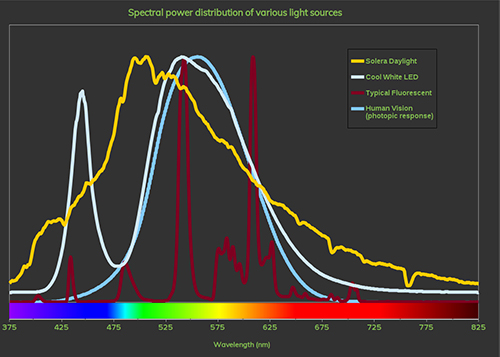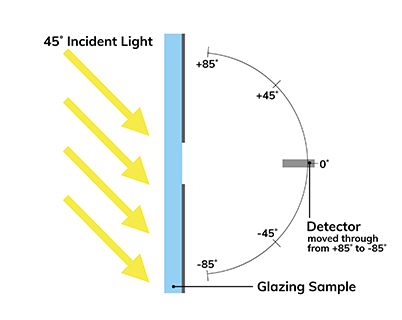Brightness and Visual Comfort in Daylighting
There are two crucial factors to visual comfort: absolute brightness and contrast. High absolute brightness can cause discomfort. For example, lightly overcast or foggy outdoor conditions, or conditions with widespread snow coverage can present uniform brightness, but the level can be uncomfortable. The absolute value of brightness that crosses the discomfort threshold varies from individual to individual, but it is typically in the range 6000-10000 cd/m².
Contrast, or large differences between bright sources in a subject's field of view and the average brightness in a scene, can be perceived as glare. In this case, the eye is adapted to the average brightness of the full field of view. If a bright source is visible, it will be a potential source of glare. A ratio of 10:1 for the immediate field of view, and 20:1 in the periphery, is generally considered reasonable.
Some guidelines suggest a maximum glazing brightness of 2500 cd/m². This is reasonable under the aforementioned ratios, as the average brightness of the walls and work area in a well-lit space will most likely be in the 100-200 cd/m² range. Translucent glazings may have higher brightness than 2500 cd/m², without presenting uncomfortable contrast. This is because they distribute the light on adjacent walls and ceilings, thus raising the average brightness in a space. Using the same acceptable ratios, and maximum absolute brightness, the maximum acceptable brightness for a translucent glazing tends to fall in the 2500-6000 cd/m² range, depending on where it is positioned.
Color Rendering and Luminous Efficiency
Daylight is the ideal source for color rendering, since our eyes have evolved to see its spectrum. Our units for light, lumens, are built on the response of the human eye. Different light sources have different power distributions across the visible spectrum, and this influences perception of color under these sources. In addition to perception, the efficiency of the source also depends on this distribution.
Spectral Power Distribution and Luminous Efficiency
The chart here shows the spectral power distribution of various light sources. The light blue line, "Photopic Response," shows the sensitivity of the human eye to bright light. The sources with the best luminous efficiency are the ones with the largest proportion of their power distribution falling inside the range of the photopic response curve. In electric lighting, part of the efficiency is dependent on how the light source is powered. Even when an electric light source emits most of its light in the visible range, some lose substantial energy as heat in the ballast driving the lamp. Daylight has great efficiency, as the majority of the power is in the visible range, and there’s no ballast or power supply to add unnecessary heat to the space.

Color Rendering Index (CRI)
The Colour Rendering Index, or CRI, is an indication of how well the spectrum of a light source will show colours correctly. Light sources that match the daylight spectrum are best, and achieve a CRI of 100. Sources with peaks, such as fluorescent lights, tend to perform poorly. Any source with a continuous spectrum will achieve very good numbers. The natural daylight transmitted by Solera® provides superior CRI performance.
Measuring Light Diffusion
LDP (Light Diffusing Power) is a metric developed by Advanced Glazings to compare the effectiveness of various translucent materials. Materials with narrow angle scattering and poor light redirecting capabilities score poorly in LDP. Solera ,with excellent wide-angle scattering, performs very well. For simplicity, a single representative scenario is measured, representing sunlight entering at a 45° angle. In essence, the measurement is simply twice the ratio of the upward redirected light/total light transmitted. A material that transmits equally in all directions (a perfect diffuser) will have an LDP of 1.0. A material with no light redirected upward ends up with 0.0.

Transmittance of materials can vary from specular to fully diffused, or some degree or combination of the two. Vision glass has purely specular transmission (i.e. light passes straight through with no scattering). Other glazing materials, such as acid-etched glass or white laminate PVB, scatter light sufficiently to obscure view, but the scattering is of a relatively narrow angle. Therefore, the brightness of those materials will vary greatly depending on your direction of view and the direction of the incident light.
Advanced Glazings’ Solera® is an excellent light diffuser, because the light that it transmits is widely scattered such that the brightness is equal in all directions. Regardless of the angle the sun strikes Solera, the unit should appear equally bright regardless of the direction of view.